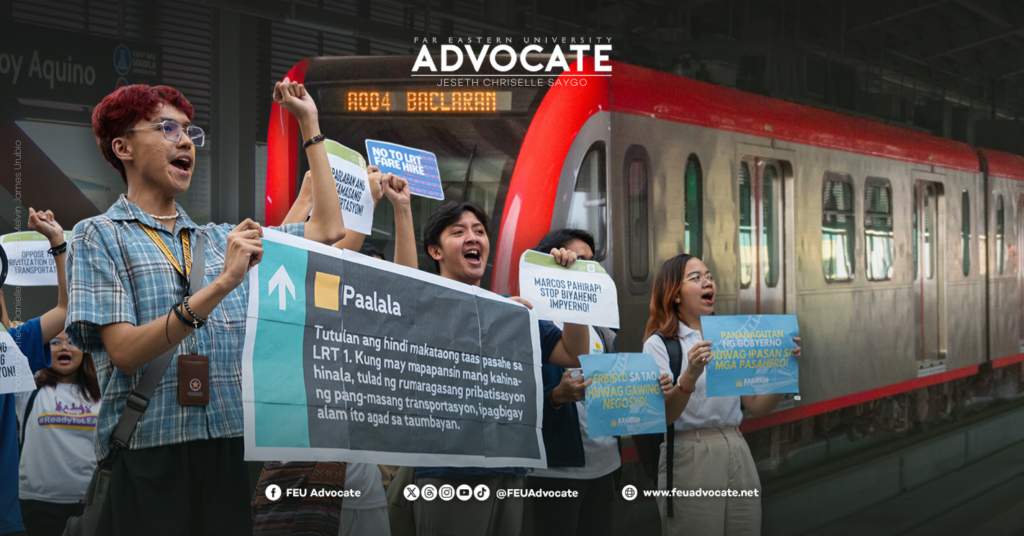
Chambers shows confidence for Owens, Amos ahead of UAAP 88
- September 16, 2025 19:54
FEU Advocate
January 20, 2025 20:56

By Shayne Elizabeth T. Flores
Struggling under different socioeconomic constraints, commuters asserted that Light Rail Manila Corporation’s (LRMC) proposed LRT-1 P7.48 average fare increase is unwarranted.
In a public hearing last January 9, LRMC proposed to implement fare hikes for LRT-1.
This is supposedly in line with the periodic fare process indicated in the 2015 Concession Agreement, stipulating that an operator may increase fares by 10.25 percent every two years.
The current base fare for LRT-1 is at P13.29, with a P1.21 increment per kilometer. This was set following the previous fare hike in August 2023.
Per the LRMC’s suggestion of a base fare of P18.15 and P1.65 increment per kilometer, fares would rise by an average of P6.02 for mid-distance passengers, P8.65 for short-distance, and P12.50 for long-distance, with an overall average of P7.48.
As a result, a single journey end-to-end trip could cost up to P60 from the current maximum fare of P45
Student-commuters’ pleas
In an interview with FEU Advocate, second-year Psychology student Fatima Joie Beltran shared that she has been commuting via LRT-1 on a mid-distance route from Doroteo Jose to Vito Cruz, with a fare of P19.
Based on the proposed hike, Beltran’s fare could go up to P25. She worries about her P500 daily allowance, P200 of which is allotted for transportation, including her tricycle fare.
“It would affect my allotted allowance for transportation on a daily basis. Especially [since] I live around five stations away, that increase would be really felt by commuters like me,” she said.
Also taking a mid-distance route from EDSA to Doroteo Jose, Psychology sophomore Miguel Antonio Zalameda currently spends P23 for each trip, which could increase to P29 with the proposed scheme.
Primarily depending on their parents’ provided allowance, the FEU students stressed their financial incapacity in light of the hike.
“Student-commuters rarely earn money to sustain themselves on their own, especially above the minimum wage. With this, an immediate spike in the LRT-1 fare, in which thousands of students commute to school everyday, will suffer yet more problems when it comes to budgeting,” Zalameda said.
Moreover, they expressed their hope for a justifiable fare in consideration of their restricted circumstances as students.
“Since we're students, we are constantly on a budget. A justifiable fare would help us budget our allowance for our essentials accordingly and avoid overspending. It is also our [right] as consumers to [be] fared on the service that we receive. In that way, as student-commuters, we won't have to think or worry that much if we are able to go home from school and vice versa,” Beltran stated.
According to FEU Central Student Organization’s recent statement resisting the proposed fare hike, 35.50 percent of the FEU student body relies on train transportation based on their previous surveys.
“It is imperative that public transportation be both affordable and reliable, ensuring that every Filipino, especially students and workers, has equal access to a safe and efficient means of travel,” the statement read.
Fare hike impact
Various progressive youth organizations outlined the impact of the fare hike on Filipino commuters, particularly students and minimum wage earners, during a picket protest held in front of LRT-1 Doroteo Jose Station last January 15.
In her speech, De La Salle-College of Saint Benilde student Lilac Fameronag emphasized the weight of the fare hike, considering students’ dependence on public transportation.
“Mukhang barya-barya lamang ang taas na P6 hanggang P15 sa pamasahe ng LRT-1, pero sa katunayan, kung araw-araw kang nagco-commute ay pumapatong-patong ang gastusin dito (The P6 to P15 fare increase seems meager, but in reality, the cost would accumulate if you commute everyday),” she expressed.
In addition to nationwide hikes, Fameronag emphasized that students across various private educational institutions are already suffering under tuition fee increases.
“Itong pagtaas sa pamasahe ng LRT-1 ay dagdag pahirap sa mga estudyante kahit saan ka man nag-aaral. Kaming mga tagapribadong pamantasan ay may kinakaharap na tuition fee increases… Ang iba’t ibang pamantasan tulad ng DLSU ay may kinakaharap na hindi bababa sa 8 percent na tuition and other fees increase (This LRT-1 fare hike is an additional burden to students regardless of their school. We, students from private institutions, face tuition fee increases… Different universities like DLSU face at least an 8 percent tuition and other fees increase),” she claimed.
Moreover, Kabataan Partylist (KPL) National President Julius Cantigan underlined students’ limited financial capacity and reliance on parent-provided allowances, which can still fall short of covering their expenses.
“Marami sa aming mga kabataan ay umaasa lang sa mga allowance na nakukuha lang din namin sa aming mga magulang na kakarampot lang din ang sahod para matustusan ang aming pag-aaral (Most of us youth just rely on the allowance provided by our parents, who also earn insufficient wage to afford our education),” he raised.
The progressive youth groups also noted the fare hike as excessive in proportion to the current minimum wage.
With approximately P20 daily fare, commuters are estimated to spend P400 pesos for transportation in a month.
In the National Capital Region alone, non-agriculture workers earn P645 per day, in contrast to the P1,205 living wage for a family of five, according to the IBON Foundation.
“Kung matutuloy ang pagtaas ng pamasahe ng LRMC sa LRT line 1 at kung hahayaan ito na mangyari nina [Marcos Jr.] at ng Department of Transportation, halos P200 hanggang P500 kada buwan ang makakaltas sa kanilang sahod (If LRMC’s proposed LRT-1 fare hike pushes through as allowed by Marcos Jr. and the Department of Transportation, approximately P200 to P500 would be deducted from their wage),” Cantigan stated.
Moreover, former Bayan Muna representative Ferdinand Gaite denounced the proposed increase in a statement, citing the highest Social Weather Stations self-rated poverty rate since 2003 of 63 percent.
“LRMC’s timing couldn’t be more callous. They’re seeking fare hikes that could reach up to P12.50 (less than $1) per ride when 63 percent of Filipino families are already struggling to make ends meet. This is the highest poverty rate we’ve seen in two decades, yet they want to burden commuters even more,” he said.
In response to LRMC’s attribution of the fare hike as a contractual obligation, Bagong Alyansang Makabayan highlighted how this rationale reflects their disregard for the public in a statement.
“They even say that they do not need to justify the increase because it is a contractual obligation. This shows how grossly disadvantageous the contract is to the public,” the group stated.
‘Serbisyo, hindi negosyo’
In light of this impending problem, the youth organizations slammed the government’s privatization of transportation.
“Walang ibang sisisihin kundi si Marcos Jr. at ang estado sa kanilang pagtupad ng mga neoliberal na patakaran at pribatisasyon, public-private partnerships kung saan lamang ang mga pribadong kompanya kaysa sa publiko (There is no one else to blame but Marcos Jr. and the state for implementing neoliberal policies and privatization, public-private partnerships where private companies overpower public ones),” Fameronag stressed.
LRT-1’s privatization dates back to 2015, when private concessionaire LRMC took over its operations and maintenance. This was preceded by LRMC’s concession agreement with the Department of Transportation (DOTr) and Light Rail Transit Authority (LRTA) for the P65 billion LRT-1 Cavite Extension, Operation and Maintenance Project signed in 2014.
Ten years later, progressive groups continue to call on the government to junk the agreement as its funds heavily relies on Filipinos’ taxes.
“Ang serbisyo sa tao ay hindi dapat ginagawang negosyo. Sa totoo lang, may pagpipilian ang gobyerno. Hindi dapat ito [gobyerno] pumirma, hindi dapat ito pumayag na ang mga pribadong kompanya ang magpasya sa pagtaas ng pamasahe. Dapat ibasura ang LRTA at LRMC concession agreement (Public service should not be made into a business. In actuality, the government has a choice. They should not have signed or agreed to have private companies control fare hikes. LRTA and LRMC’s agreement should be junked),” Jolina Castro of Kalikasan People’s Network for the Environment said in her speech.
Apart from easing the hike, Student Christian Movement of the Philippines National Chairperson Kjerrimyr "Kej" Rodrigo Andres advocated for waiving the LRT-1 fare altogether.
“Sa budget ng LRT, sa totoo lang, kayang-kaya ng gobyerno na tustusan [ito]… Kaya ng gobyerno na gawing libre ang pagsakay sa tren (With LRT’s budget, the government could really make train services free),” he said.
In light of LRTA’s generated revenue of P1 billion in 2022 and P1.65 billion in 2023, Andres suggested the state’s capacity to fully cover citizens’ train fare by utilizing President Ferdinand ‘Bongbong’ Marcos Jr.’s confidential funds.
“Ibig sabihin, kung isusuko ni Bongbong Marcos ang kaniyang confidential funds, kayang gawing libre ang LRT sa loob ng apat na taon (This means that if Bongbong Marcos gives up his confidential funds, LRT service can be made free within four years),” he claimed.
Additionally, the government should raise the minimum wage instead of fare prices according to the KPL National President.
“Ito ang mga priorities na dapat isipin at dapat unahin ng pamahalaan o ng Marcos administration, hindi ang pagtaas ng pamasahe ng LRT-1 (These are the priorities the government of Marcos administration should focus on, rather than increasing the LRT-1 fare),” he added.
DOTr Secretary Jaime Bautista said that the proposed fare increase could take effect as early as April, if approved.
As of the latest data from 2023, the average daily ridership of LRT-1 is between 350,000 and 370,000.
(Photos by Thea Danielle Morin and Melvin James Urubio/FEU Advocate; Layout by Jeseth Chriselle Saygo)









